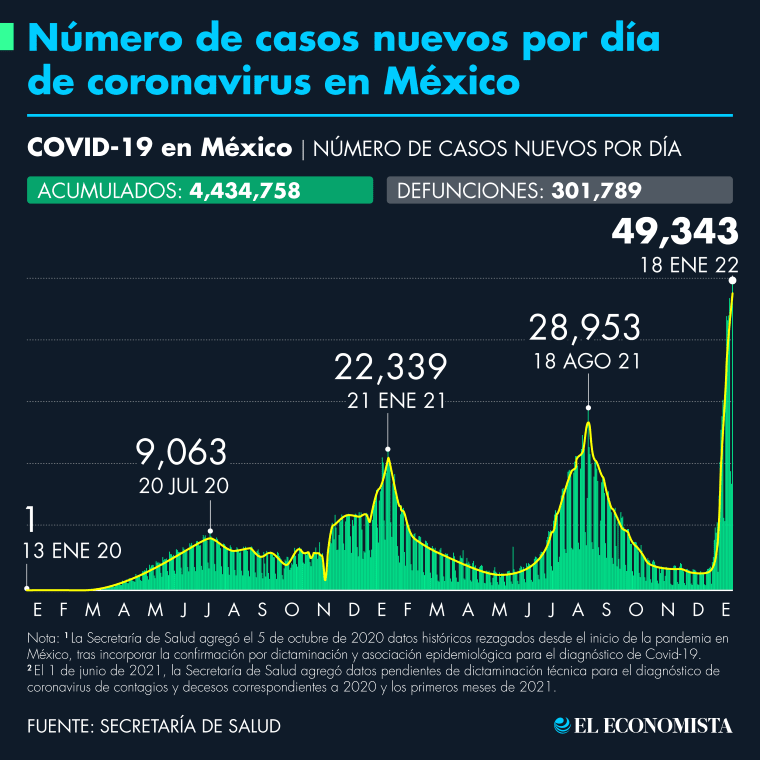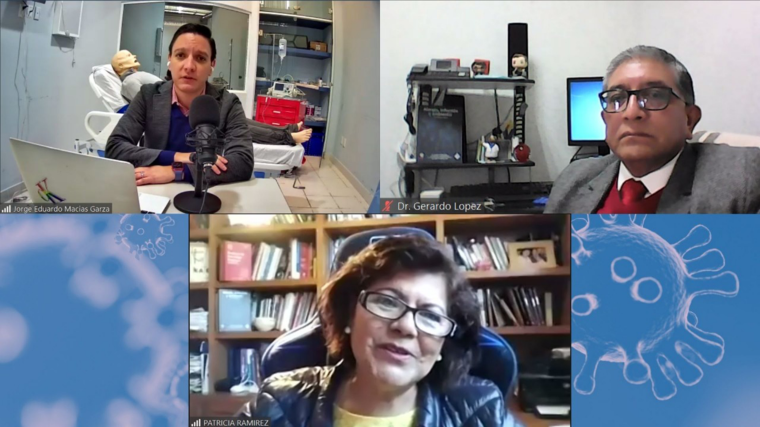Given the increase in cases of Covid-19, infectionology specialists have shared a real perspective on the recovery in infection in Mexico. Patricia Ramírez, a pediatric infectionologist and researcher at the National Institute of Pediatrics, said it was convenient from the start to know which viruses predominated in it. winter season: the rhinovirus, which is present from September to June, the flu, promoted by cold climates, and now the coronavirus which he assures, “is here to stay”.
From 11 March 2020, the Covid-19 has been declared by the World Health Organization (WHO) as a pandemic; In Mexico, the first case was registered on February 27, 2020, since then the data so far show 4 million 434,758 accumulated cases and 301,789 deaths. For the past 24 hours, Mexico has had a new maximum record for daily infections with 49,343 cases and 320 deaths, according to the latest report from the Ministry of Health, which shows that we are still experiencing significant problems.

Where are we in the pandemic?
Dr. Ramírez explains that this virus still causes deaths, albeit at a lower percentage, but it still represents an increase in cases, as confirmed by the Deputy Secretary for Prevention and Health Promotion, Hugo López-Gatell, who assured this Tuesday that infections are now they are 10 times greater than the hospitalizations and deaths registered in Mexico. for what is it?
Also a member of the Mexican Society of Pediatric Infectious Diseases explains that today the 21K or B1.1.529 variant predominates, better known as Omicron, which consists of four structural proteins, and of which S has been studied above all, which is the peak or peak, but it also has proteins M, N and E. It also has 16 non-structural proteins, which also help viral replication and evasion of the immune system. As if that were not enough, it has 6 other additional proteins that also help the virus to activate, replicate and overcome the immune system.
According to the GISAID system that monitors variables worldwide, more than 40 mutations were observed for Omicron by January 17, making the virus more replicating and more contagious. Today the Omicron variant It dominates in many parts of the world, such as the United Kingdom, the United States, Brazil and Mexico among them.
“In short, we are facing a variant with a greater number of mutations that evade the immune system, less aggressively, but more transmissively, especially between the third and sixth day after the onset of symptoms.”
How can we identify if the strain is Ómikron?
The World Health Organization (WHO) states that there is still no certain evidence that symptoms by Omicron differs from other variants. However, several studies around the world find small differences in symptoms that occur in patients with the new variant, for example, it is more contagious in the nasal upper airway, has fewer diseases in the lower airway (pulmonary) and has a higher risk of re-infection , even in patients who have already had the infection or a complete vaccination schedule.
A study published by the United States Centers for Disease Control and Prevention (CDC) confirmed this most common symptom of people infected with Omicron variant is the dry cough, affecting up to 89% of people; Other is fatigue (65%), nasal congestion (59%), fever (38%), nausea Y thrown up (22%), in addition to headaches, body aches and sore throats, all offered light and lasted from two to five days. These are some differences to the inconvenience caused by the original virus.

Patricia Ramírez, Jorge Eduardo Macías and Gerardo López participated in the panel of specialists on the Omicron variant of Covid-19. Photo EE: Special / Capture video.
What can we do in this scenario?
Dr. Jorge Eduardo Macías, a specialist in clinical immunology and pediatric allergy, identifies some common prevention and care measures that we should not forget for this season of complications.
Vaccines: it is the primary prevention that will reduce the severity and mortality associated with this new virus. Although it does not prevent infection, what it does do is that our body previously knows a part of the virus so that it can respond much faster and adequately when it occurs. He said the brand of the vaccine does not matter for now, as everyone has shown high safety and efficacy, the most important thing is that the more population is vaccinated, the less serious disease we will have and fewer deaths.
Face mask: It should continue to be used because we can be asymptomatic and infect people who have not been vaccinated or who have some risk factor leading to the development of a serious illness. The best mouth cover is the one that makes you breathe, that does not have an escape valve, that covers the nose and mouth, that has a sufficient closure on the sides, the metal band on the nose helps a lot, in this sense the KN95 showed effectiveness for the general population. The real thing if we have to eat food is to remove it completely, fold it in half and then put it back.
healthy distance: It is 1.8 meters, so if someone sneezes, it is the distance at which the particles start to decrease and fall to the ground. Therefore, crowded places that do not allow healthy distance should be avoided. Even if there is a sneeze, the mask will not be enough, so we use the curve of the elbow to cover ourselves.
Handewas: Although it has been known since childhood, it is used as a base before every meal, after going to the bathroom, before preparing food, it is now added after contact with various surfaces that have been exposed to more people. The wax is with a sufficient circulation movement to generate foam, between the fingers, top and bottom, knuckles, thumbs, in the middle of the palm and nails; with the paper with which we dry ourselves is the same with which we will turn off the tap.
insulation and testing: Given the suspicion of some kind of infection due to contact with a positive patient, voluntary isolation or quarantine is the first part, here what we are looking for is to see if symptoms develop and whether the disease occurs or not, in order to do more to avoid infections. In the event of a test and a positive outcome, it is important to notify the people you have had contact with. Testing is also very important before a trip or an unavoidable meeting.
Supervision: Once we have the symptoms, supervision is very important, for this there is a decalogue published by the CDC, among the points are: insulation at home, monitoring of symptoms (oxygen and temperature), rest and hydration, an emergency cell phone , use a tissue to sneeze, wash your hands as often as possible, isolate yourself from people you normally live with, avoid contact with people with active infections, avoid sharing items and disinfect constantly.
kg
Reference-www.eleconomista.com.mx